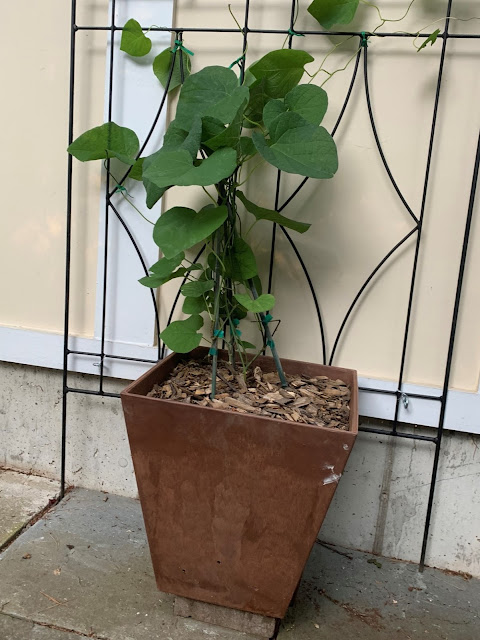While the weather is hot and dry, I’m thinking about ways to keep the house cool while saving energy. I hope we’ll be installing a heat pump in the next year. That would really help. Until then, I’ve made a modest start by planting a large-leaved vine in front of west-facing windows.
 |
| Young pipevine on July 4 |
After weighing native candidates for this spot, in May I spotted an excellent option: pipevine or Dutchman’s pipe (Aristolochia macrophylla, also called A. durior) at the native plant shop at Garden in the Woods. This native of eastern North America is mostly grown for its large heart-shaped leaves.

Pipevine shading a neighbor's house
The common name refers to its unusual flower, shaped somewhat like a smoker’s pipe.
 |
| Pipevine flower-photo Adam Skowronski |
Pipevine is the larval host plant for the native pipevine swallowtail butterfly (Battus philenor).
 |
| Pipevine swallowtail-photo John Flannery |
The vine protects itself from leaf-eating insects by storing toxic chemicals in its tissues. Pipevine swallowtail caterpillars are able to concentrate these safely in their own bodies, making themselves and the adult butterflies they metamorphose into poisonous to predators. Monarchs use the same strategy with toxins in milkweeds.
If I see flowers on my pipevine, it’ll be a bonus. My main goal is for the densely-growing leaves to shade two kitchen windows that get unobstructed afternoon sunlight in summer, heating up the room uncomfortably. The vine should reduce solar gain. As it transpires water from its leaves, it’ll cool the nearby air a bit, forming a cooler layer between the windows and the outside air.
For now, I’ve placed the vine in a large planter. It’s a fast grower. Since May, it’s sent out long tendrils that are already covering the bottom half of the windows. This week Steve helped me to put up a curtain rod above the window frames to hang some netting above the trellis I’d installed.
 |
| Trellis plus netting to support the pipevine |
The vine seems ready to spread upward. If it grows into the rain gutter, I’ll have to trim it back with my pole pruner.
In late fall, I’m planning to cut the pipevine down to soil level and move it into the basement for the winter. During the cold months, we welcome all the solar gain we can get. At this rate of growth, I don’t doubt it can expand to shade the windows anew every summer. If this one thrives, I could cover more of the west-facing wall by adding more containers of pipevine or removing a bluestone paver and planting the cold-hardy vine directly in the ground.
Years ago I planted a pipevine at the front of the house, hoping to cover a stretch of fence. That vine has never flourished, probably because it’s shaded by the house, a tall oak, and a row of spruces along the lot line, with a Japanese maple getting taller and denser on its other side every year.
 |
| Just hanging on in too much shade |
It’s instructive to see how fast the new vine is growing with a half day of direct sun. I’d say it’s getting what it needs.
No comments:
Post a Comment